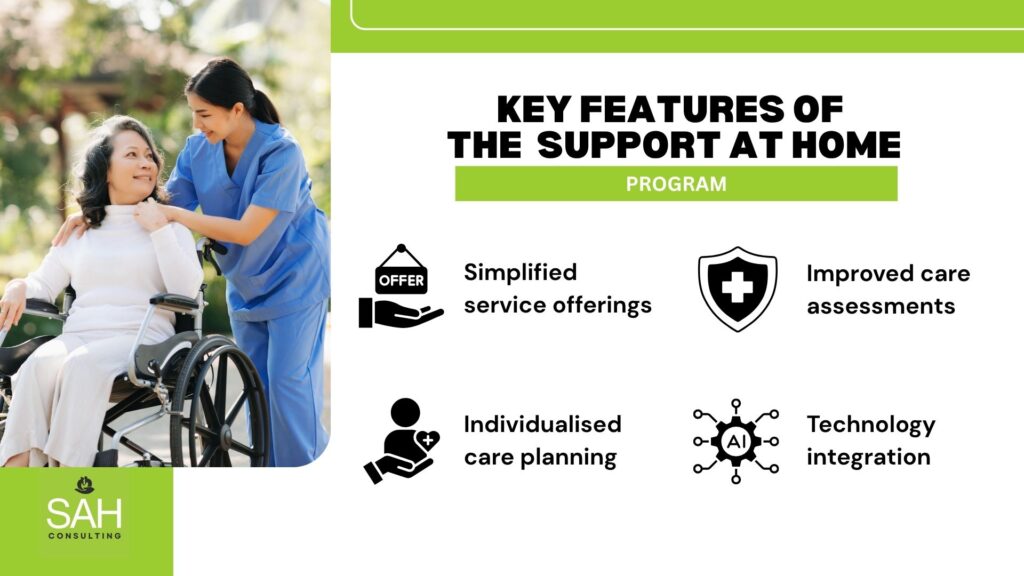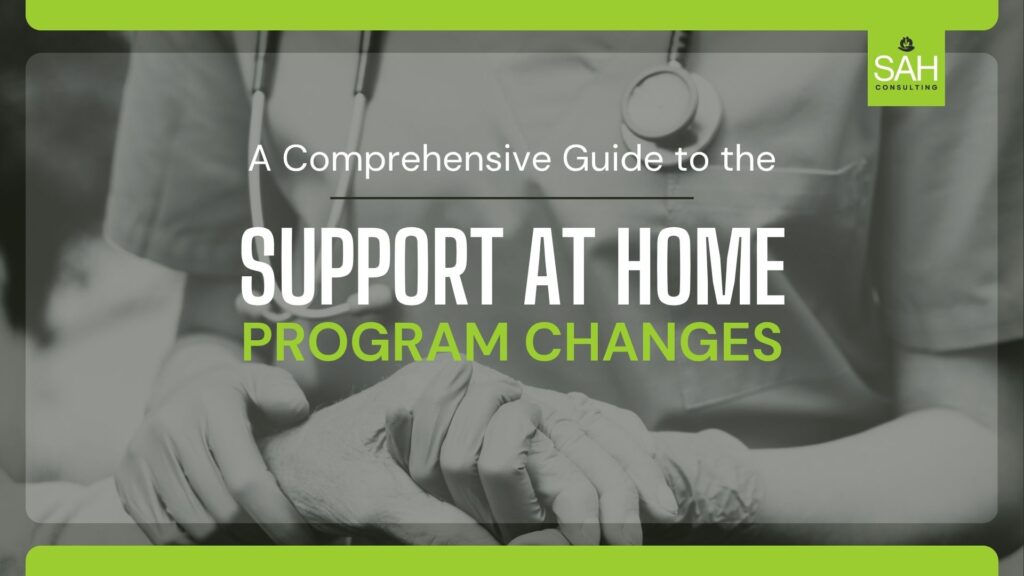Australia’s aged care system is going through major changes and many are asking: what are the new aged care reforms all about? To better support older people who wish to remain living independently at home, the government is introducing the Support at Home Program, a simplified model that replaces several existing in-home care schemes with one coordinated framework. This shift follows key recommendations from the Royal Commission into Aged Care Quality and Safety and aims to make services more accessible, consistent, and tailored to individual needs.
For providers, the reforms bring new responsibilities, including updates to compliance, reporting, and care delivery. If you’ve been wondering what the new aged care reforms are and how they’ll affect your operations, SAH Consulting is here to help. We offer clear, practical guidance to help you adapt to regulatory changes, revise internal policies, and adjust service models with confidence.
What is the Support at Home Program?
The Support at Home Program is a new government initiative designed to bring greater clarity and consistency to in-home aged care. It will combine the Home Care Packages (HCP) and the Commonwealth Home Support Programme (CHSP) into a single, streamlined system. By replacing these separate programs with one cohesive framework, the aim is to make it easier for older Australians to access the right support at the right time. This approach also reduces complexity for providers and ensures care is better aligned with each individual’s needs.
A key focus of the program is promoting independence, allowing older Australians to remain in their homes safely and comfortably for as long as possible. With funding set to grow alongside the ageing population, the program is expected to support 1.4 million older Australians, with an additional 300,000 beneficiaries by 2034-35. The new system will introduce fairer assessments and better resource allocation, ensuring that services are tailored to each individual’s needs.
The Support at Home Program brings a range of improvements to how care is delivered. Key changes include updated assessment and classification methods to ensure services are distributed more fairly. There is also a stronger focus on early intervention, helping older Australians stay active and independent for longer. For those with more complex needs, the program offers access to higher levels of tailored support.
Why is the Support at Home Program Being Introduced?
Australia’s current home care system has been criticised for being complex and difficult to navigate. The Royal Commission into Aged Care Quality and Safety highlighted issues like long wait times, inconsistent care, and administrative burdens. In response, the Support at Home Program was introduced to simplify access, improve fairness, and ensure seniors receive timely and appropriate care.
The new program increases funding for in-home care, raises the maximum annual support from $61,440 to $78,000, and provides access to a care partner for better service coordination. Wait times for services will be reduced to three months by 2027, and seniors can access upfront funding for assistive technology and home modifications. The program also expands short-term restorative care and introduces an End-of-Life Pathway, offering up to $25,000 over three months to support those in palliative care at home. These updates form a key part of the aged care reforms summary, highlighting the government’s commitment to more responsive and person-centred support.
Key Features of the Support at Home Program

The new program introduces several key features to improve the delivery of home care services:
- Simplified service offerings: Streamlining multiple services into one program.
- Individualised care planning: Focus on tailored care based on individual needs.
- Improved care assessments: Centralised and standardised assessments for better service matching.
- Technology integration: Use of digital tools to manage care and communication.
Benefits of the Support at Home Program for Aged Care Providers and Consumers
For Providers:
The Support at Home Program offers significant benefits for aged care providers, including reduced administrative burden through streamlined processes and simplified service offerings. Clearer funding models provide transparency and predictability, facilitating better resource allocation and financial planning.
For Consumers:
For consumers, the Support at Home Program empowers individuals with greater choice and control over their care. Tailored care planning ensures services are aligned with personal needs and preferences, promoting independence and quality of life. Improved care assessments and service matching ensure seniors receive appropriate and timely support.
Key Changes You Need to Prepare For
Transition Timeline and Government Support
The Support at Home Program will launch on 1 July 2025, replacing existing in-home aged care services. Current Home Care Package (HCP) recipients will automatically transition to the new system unless their care needs require reassessment. The government will provide resources to support both care providers and recipients in understanding and adapting to the changes.
Compliance Requirements and Reporting Changes
Aged care providers must comply with updated reporting and regulatory requirements under the new program. This includes stricter guidelines on care delivery, documentation, and service quality assessments. To stay compliant, providers should review new standards, implement internal audits, and ensure staff are trained in the revised protocols.
Changes in Service Delivery Models
The program places a stronger emphasis on holistic and personalised care, ensuring services align with each individual’s needs. Assessments will be conducted through the Single Assessment System using the Integrated Assessment Tool (IAT), which standardises evaluations and ensures appropriate care levels. This shift requires providers to adopt a more tailored approach when developing care plans for seniors.
Digital Tools and Technology Integration
Technology will play a crucial role in service delivery, requiring providers to integrate digital platforms for scheduling, documentation, and communication. Implementing care management software will help track client progress, streamline operations, and improve coordination between care teams. Providers should invest in systems that support real-time updates and secure data management.
Workforce Training and Upskilling
Care staff must be trained to meet the updated care standards and effectively use the new assessment tools. Professional development programs should focus on personalised care planning, digital literacy, and compliance with revised guidelines. Investing in staff upskilling will ensure smooth adaptation to the new system and improve care quality.
Support at Home Pricing & Funding Updates
The new program introduces a structured contribution model based on the type of service received and a participant’s financial situation. Full pensioners will not pay for clinical care and will contribute only 5% toward independence services. Self-funded retirees, however, may contribute up to 80% for everyday living services, ensuring funding is distributed more equitably.
Enhanced Communication Strategies
Clear and open communication with clients and families is essential to build trust during the transition. Providers should establish protocols to keep clients informed about service changes, new care options, and financial contributions. Regular updates through newsletters, meetings, or digital platforms will help ensure a smooth transition and address any concerns early on.
How SAH Consulting Can Help
At SAH Consulting, we support aged care providers in adapting to the changes brought by the Support at Home Program. Our goal is to simplify the transition and help you stay compliant with the latest standards. If you’re asking what the new aged care reforms are and how they affect your operations, we’re here to guide you every step of the way.
Our team can assist with:
- Interpreting and applying new regulatory requirements
- Preparing detailed and accurate applications
- Compiling essential documentation to meet compliance standards
- Developing clear and practical policies and procedures
- Addressing concerns quickly and resolving potential issues early
- Minimising delays to ensure a smooth, uninterrupted transition
With SAH Consulting by your side, you can approach the reforms with confidence and keep your services running efficiently.
Conclusion
Adapting to the Support at Home Program is essential for aged care providers who want to remain compliant and continue delivering quality care. The shift brings new regulations, funding updates, and service delivery changes that can feel complex to navigate. If you’re still wondering what the new aged care reforms are and how they apply to your organisation, now is the time to seek expert guidance. With the right support in place, providers can manage the transition smoothly and build a stronger foundation for the future.
SAH Consulting offers expert guidance to help navigate these updates, minimise disruptions, and ensure compliance with the new framework. Book a free consultation today and take the next step toward a smooth and confident transition.
